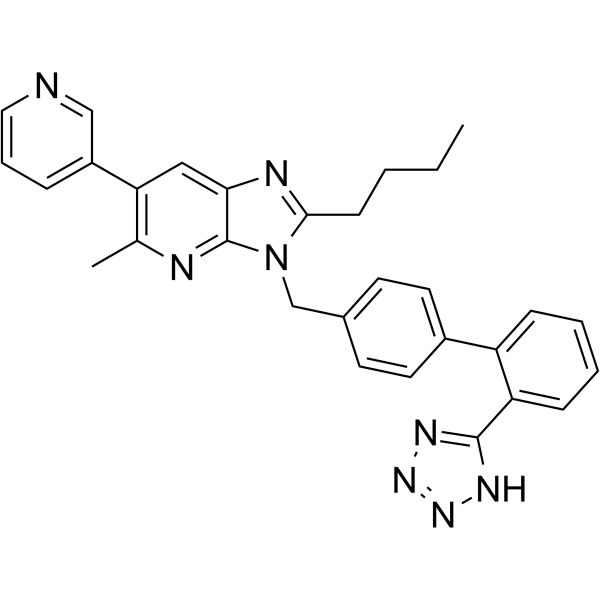
TM-25659
CAS No. 260553-97-7
TM-25659( —— )
Catalog No. M26484 CAS No. 260553-97-7
TM-25659 is a modulator of transcriptional co-activator with PDZ-binding motif (TAZ), with anti-osteoporotic and anti-obesity activities.
Purity : >98% (HPLC)
 COA
COA
 Datasheet
Datasheet
 HNMR
HNMR
 HPLC
HPLC
 MSDS
MSDS
 Handing Instructions
Handing Instructions
| Size | Price / USD | Stock | Quantity |
| 2MG | 71 | In Stock |


|
| 5MG | 115 | In Stock |


|
| 10MG | 177 | In Stock |


|
| 25MG | 425 | In Stock |


|
| 50MG | 624 | In Stock |


|
| 100MG | Get Quote | In Stock |


|
| 200MG | Get Quote | In Stock |


|
| 500MG | Get Quote | In Stock |


|
| 1G | Get Quote | In Stock |


|
Biological Information
-
Product NameTM-25659
-
NoteResearch use only, not for human use.
-
Brief DescriptionTM-25659 is a modulator of transcriptional co-activator with PDZ-binding motif (TAZ), with anti-osteoporotic and anti-obesity activities.
-
DescriptionTM-25659 is a modulator of transcriptional co-activator with PDZ-binding motif (TAZ), with anti-osteoporotic and anti-obesity activities.(In Vitro):Treatment with TM-25659 (2, 10, 20, 100 μM) dose-dependently enhances nuclear TAZ localization and attenuates PPARγ-mediated adipocyte differentiation by facilitating PPARγ suppression activity of TAZ. Osteogenic gene expression is enhanced by TM-25659 (2, 10, 50 μM) and thereby osteoblast differentiation is increased.(In Vivo):In vivo, TM-25659 (50 mg/kg, i.p., every other day for 2 weeks) suppresses bone loss and decreases weight gain in an obesity model. The plasma concentration of TM-25659 declines with an approximate t1/2 of 7 or 10 h following i.v or p.o. administration respectively. The systemic clearance (CL) is 0.21 L/(h×kg) and the volume of distribution at steady-state (1.91 L/(h×kg)) is larger than the volume of total body fluids.
-
In VitroCell Proliferation Assay Cell Line:3T3-L1 cells Concentration:2, 10, 20, 100 μM Incubation Time:6 days Result:Acted as a suppressor of PPARγ-dependent adipocyte differentiation.
-
In VivoAnimal Model:C57BL6 mice (4- to 6-week-old )Dosage:50 mg/kg Administration:I.p., every other day for 2 weeks Result:Attenuated weight gain in these obese mice.Animal Model:Adult male Sprague-Dawley rats Dosage:10 mg/kg Administration:I.v. (2, 10 and 30 min), oral (15 and 30 min, and 1, 2, 4 and 8 h)Result:Oral administration for 4 weeks moderately but significantly attenuated weight gain and partly restored BMD in the OVX rats.
-
Synonyms——
-
PathwayOthers
-
TargetOther Targets
-
RecptorHCV
-
Research Area——
-
Indication——
Chemical Information
-
CAS Number260553-97-7
-
Formula Weight500.6
-
Molecular FormulaC30H28N8
-
Purity>98% (HPLC)
-
SolubilityIn Vitro:?DMSO : ≥ 135 mg/mL (269.68 mM)
-
SMILESCCCCc1nc2cc(-c3cccnc3)c(C)nc2n1Cc1ccc(cc1)-c1ccccc1-c1nn[nH]n1
-
Chemical Name——
Shipping & Storage Information
-
Storage(-20℃)
-
ShippingWith Ice Pack
-
Stability≥ 2 years
Reference



-
DL-Mevalonolactone
Mevalonic acid is very soluble in water and polar organic solvents.
-
PTD-p65-P1 Peptide
PTD-p65-P1 Peptide is a nuclear transcription factor NF-kappaB inhibitor, composed of a membrane-translocating peptide sequence generated from antennapedia (PTD) conjugated with p65-P1, which selectively inhibits activation induced by various inflammatory stimuli. PTD-p65-P1 suppressed NF-kappaB activation induced by lipopolysaccharide, interleukin-1, okadaic acid, phorbol 12-myristate 13-acetate, H(2)O(2), and cigarette smoke condensate as well as that induced by TNF.
-
ACTH 1-13
ACTH (1-13) is a 13-aa peptide, with cytoprotective effects in the model of ethanol induced gastric lesions in rats.Adrenocorticotropic hormone (ACTH), also known as corticotropin, is produced and secreted by the anterior pituitary gland. ACTH is an important component of the hypothalamic-pituitary-adrenal axis as a response to biological stress.



 Cart
Cart
 sales@molnova.com
sales@molnova.com


